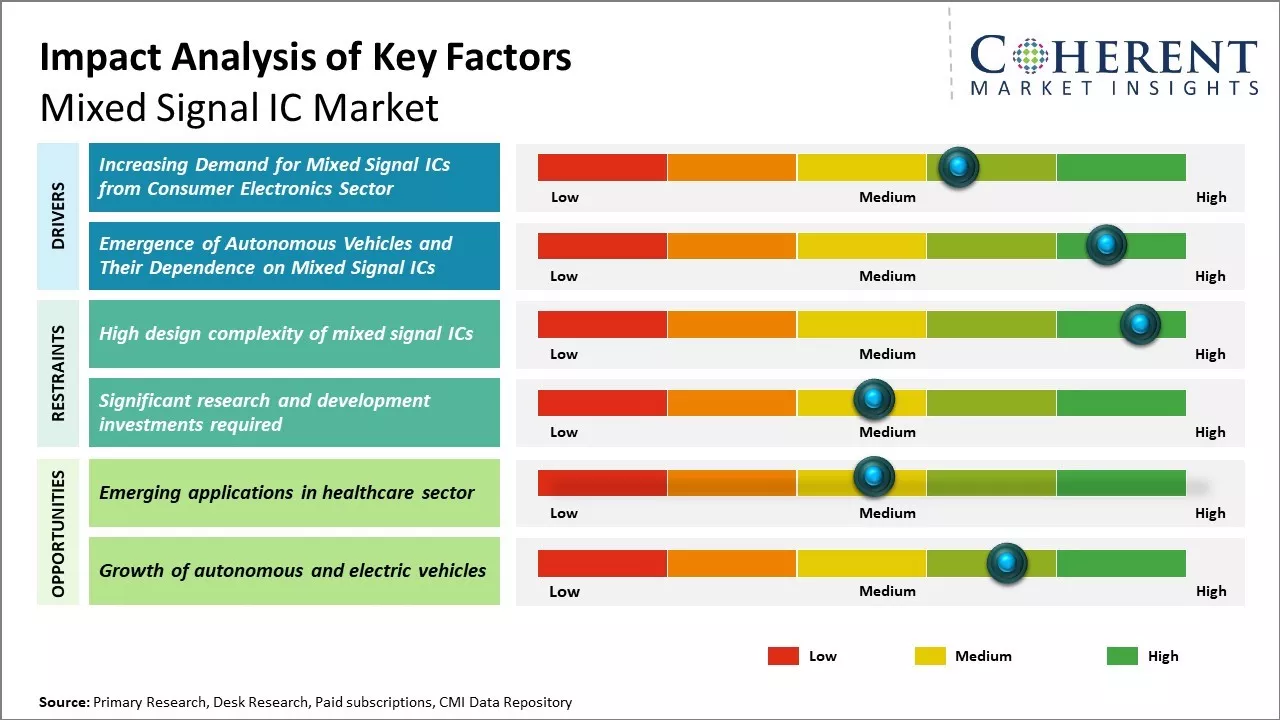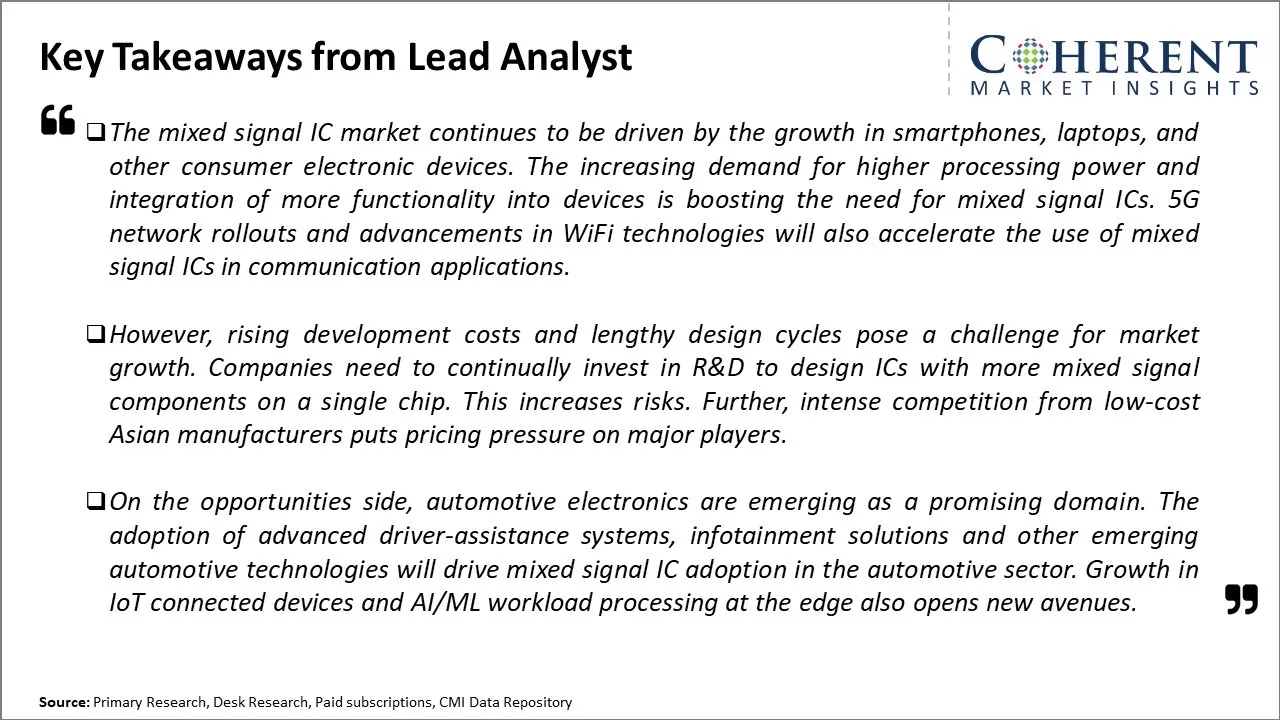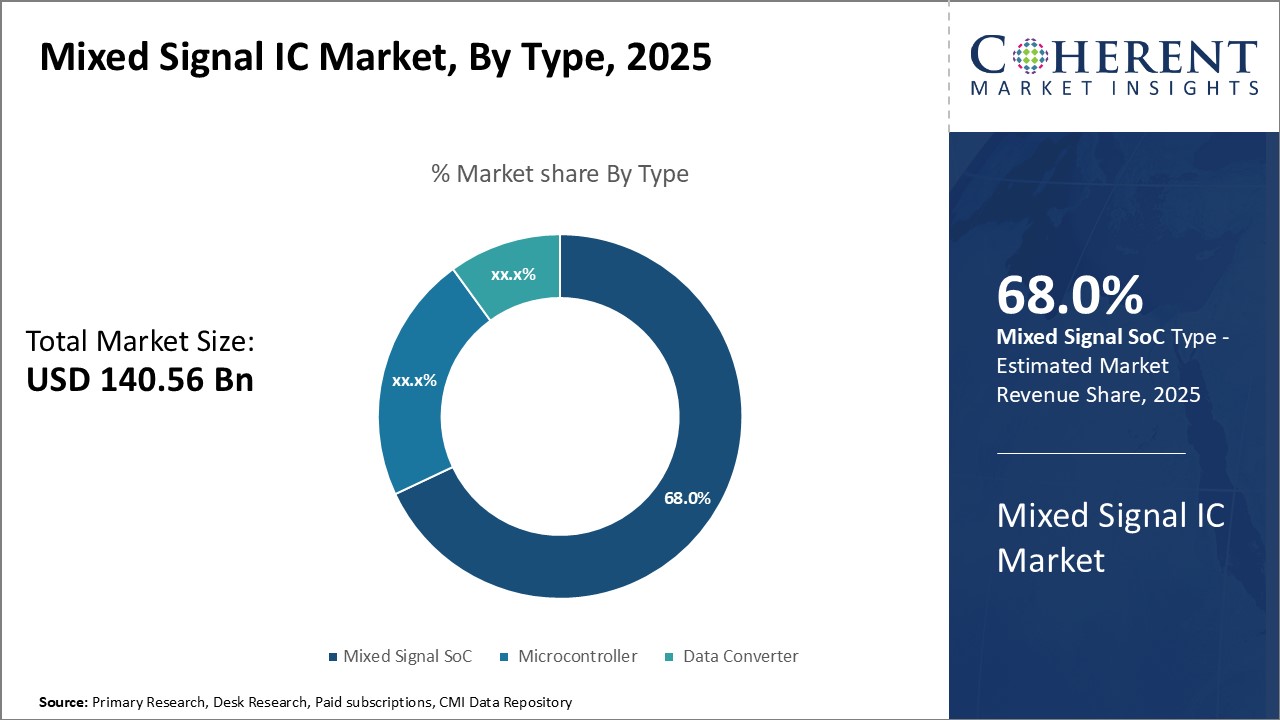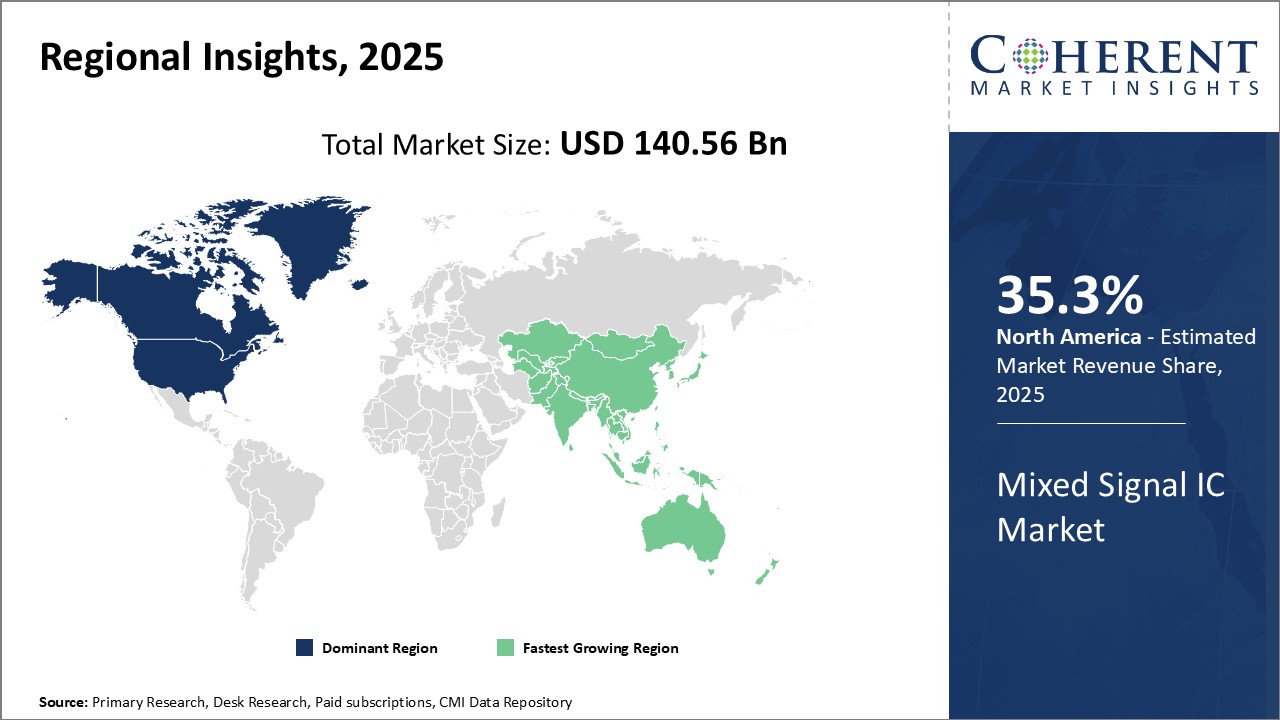Global mixed signal IC market is estimated to be valued at USD 140.56 Bn in 2025 and is expected to reach USD 231.83 Bn by 2032, exhibiting a compound annual growth rate (CAGR) of 7.4% from 2025 to 2032.

Discover market dynamics shaping the industry: Request sample copy
Various end-use industries such as consumer electronics, IT & Telecom, and automotive have been adopting mixed signal ICs due to its increasing demand for complex systems with integrated functionality. There has been huge demand for mixed signal ICs from the industrial sector over the years. Growing applications of mixed signal ICs in areas such as factory automation, machine control systems, and power management can drive the market growth during the forecast period.
Market Driver: Increasing Demand for Mixed Signal ICs from Consumer Electronics Sector
Growing consumer electronics industry boosts demand for mixed signal ICs. As new consumer electronic products are being introduced at a rapid pace providing more advanced functionalities, it is placing greater demand for sophisticated mixed signal electronics. Consumer electronics such as smartphones, laptops, tablets, smart watches and other wearable devices require mixed signal ICs to enable key functions. Virtually all modern consumer devices uses a variety of mixed signal ICs to support important operations related to processing, communications, sensing and power management.
Nowadays, leading smartphones are highly integrated systems that leverage mixed signal ICs across myriad applications from baseband communications, graphics processing and camera image signal processors to RF transceivers, fingerprint and other biometric sensors. As the functionality and performance of these devices increases with each new release, manufacturers need to implement more compact and power efficient solutions. This relies on integrating additional mixed signal circuits into standard chips or dedicated SOCs. Tablets, laptops and other mobile devices follow similar trends of increasing mixed signal IC integration as these adopt new features commonly seen on smartphones. Beyond mobile devices, other consumer products like smartwatches, wireless earbuds, augmented/virtual reality headsets and smart home appliances also uses mixed signal solutions.
Growing number of connected devices and emerging applications of AI/ML, boosts demand for augmented reality and IoT. Smart speakers, home automation hubs and other IoT devices rely on mixed signal functionality for harvesting sensor data, real-time audio/visual processing and low power control. As AI/ML algorithms improve, more computational power needs to reside at the edge using specialized mixed signal processors. The advanced consumer applications like augmented reality headsets require high performance mixed signal technologies for delivering low latency processing and sensory immersion.
For Instance, In July 2022, Siemens EDA Introduces Enhanced Mixed-Signal IC Verification Platform.

Get actionable strategies to beat competition: Request sample copy
Market Driver: Emergence of 5G TechnologyThe rapid adoption of 5G technology is a key driver propelling the global mixed signal IC market, with forecasts predicting a robust CAGR of over 8%. 5G's high-speed, low-latency capabilities are fueling demand for sophisticated mixed signal ICs across industries like automotive, healthcare, and consumer electronics. Additionally, the expansion of smart devices and IoT applications further boosts this demand. As industries digitize and automation gains traction, mixed signal ICs play a crucial role in enabling seamless integration of analog and digital functionalities, supporting sensor interfacing, data conversion, and signal conditioning. This trend underscores the pivotal role mixed signal ICs play in powering next-generation communication, connectivity, and automation technologies, driving the semiconductor industry forward.

To learn more about this report, Request sample copy
Market Challenge: Process Technology Transition ChallengesTransitioning to newer process technologies with smaller geometries requires significant R&D investments. Maintaining compatibility with older designs while advancing to newer nodes poses technical difficulties. Assembly and testing complexity increases with hybrid digital-analog designs. Volatile commodity prices and macroeconomic uncertainties could impact demand from end markets like automotive and industrial. Geopolitical tensions are disrupting global supply chains. Rising competition from low-cost suppliers adds pricing pressure.
Market Opportunity: Emerging Technologies Drive Demand
Growing sectors like wireless communications, IoT, automotive and industrial electronics can boost demand for mixed signal solutions. Design wins in cutting-edge applications like 5G connectivity, autonomous driving and smart home/building systems can bolster revenue. Expanding chip content in electronic products opens up an avenue for increased market share.

Discover high revenue pocket segments and roadmap to it: Request sample copy
Insights, By Type- Mixed Signal SoC segment contributes the highest share of the market due to increasing demand for integrated solutionsAmong type, mixed signal SoC segment is estimated to contribute the highest market share of 68.0% in 2025, due to rising demand for integrated solutions from various end-use industries. Mixed signal SoC combines both analog and digital components into a single chip, thus, facilitating miniaturization and improving performance. Growing demand for compact devices across consumer electronics, automotive, industrial and other sectors boosts adoption of mixed signal SoC.
Convergence of different technologies into a single system-on-chip has enabled the development of advanced and sophisticated electronics. Mixed signal SoC allows for integration of functions such as processing, connectivity, sensing and power management on one silicon solution. This has significantly enhanced the capabilities of various products while reducing their footprint. The trend towards development of smarter and connected devices hinges on the ability of SoC to integrate both analog and digital components. Rising need for improved functionality, smaller form factors and lower production costs have augmented the application of mixed signal SoC solutions.
Advancements in SoC design technologies are further widening their application scope. Improvements in bandwidth, power consumption and transistor counts have bolstered the potential of mixed signal SoC. Improving integration levels and versatility of SoC can boosts its adoption across diverse applications in the near future.
Insights, By End-use- Consumer electronics contributes the highest share due to growing demand for connected devices
Among End-use, consumer electronics segment is estimated to contribute highest market share due to rising demand for connected consumer devices. Electronics manufacturers are increasingly focusing on development of smart and IoT-enabled home appliances, wearables, infotainment systems and other products. This growing complexity has boosted the need for more powerful and efficient mixed signal ICs that can facilitate faster data processing, improved connectivity and versatile sensing capabilities.
Rising disposable incomes and availability of low-cost connected devices are encouraging widespread adoption of smart home and wearable technologies. Consumers seek devices with features such as voice assistance, seamless connectivity, advanced environmental/health monitoring and cloud-based service integration. Meeting these evolving performance requirements relies upon integration of several analog and digital components on a single chip. Advanced mixed signal SoC and microcontroller ICs effectively address the stringent power, size and cost constraints of consumer devices.
Emerging technologies such as 5G, AI/ML and augmented/virtual reality are expected to further accelerate intelligentization of consumer products. Growing reliance on connectivity, sensing, data processing and power management functions boosts demand for specialized mixed signal solutions from this industry. The consumer electronics segment is therefore anticipated to remain the major revenue generator for mixed signal IC vendors in the foreseeable future.

Need a Different Region or Segment? Customize now
North America has emerged as the dominant region with market share of 35.3% in 2025, in the global mixed signal IC market due to strong presence of leading semiconductor companies such as Intel, Texas Instruments and Analog Devices in the region. These companies have made huge investments in R&D to develop advanced mixed signal ICs and also enjoy a large captive customer base in sectors like automotive, industrial, communication and consumer electronics.
The U.S. market alone contributes to over 40.5% of the global demand for mixed signal ICs. Easy availability of skilled workforce and expertise in the semiconductor domain drives the regional market growth. Local manufacturing allows these companies to maintain strong customer relationships and quickly address the diverse needs of the market. Exports of mixed signal ICs from the region have also been growing steadily.
Asia Pacific region has emerged as the fastest growing market for mixed signal ICs globally due to rising adoption of consumer electronics and automotive products across emerging economies like China, India, South Korea and others. Rising disposable incomes and digitization of devices boosts demand from sectors such as mobile devices, laptops, automotive electronics and smart home appliances.
Countries like China and South Korea has mixed signal IC design companies which are catering to the needs of the domestic market as well as global OEMs. Taiwan has emerged as a key regional player with companies like MediaTek and Novatek dominating the smartphone SoC market. These companies undertake extensive R&D to develop specialized mixed signal solutions at competitive prices for fast growing end-use sectors. Rapid growth of fabless design companies and foundries in the region indicates its rising prominence.
Regional pricing dynamics also influence customer preferences. While North America dominates high-value specialty ICs, Asian companies have an advantage in high-volume commodity grade products. This competitive pricing is enabling Asian mixed signal IC suppliers to strengthen their global market share. With digitization trends accelerating across industries, Asia Pacific is well positioned to sustain its momentum as the fastest growing regional market in the future.
Mixed Signal IC Market Report Coverage
| Report Coverage | Details | ||
|---|---|---|---|
| Base Year: | 2024 | Market Size in 2025: | USD 140.56 Bn |
| Historical Data for: | 2020 To 2024 | Forecast Period: | 2025 To 2032 |
| Forecast Period 2025 to 2032 CAGR: | 7.4% | 2032 Value Projection: | USD 231.83 Bn |
| Geographies covered: |
|
||
| Segments covered: |
|
||
| Companies covered: |
AMS OSRAM AG, Analog Devices Inc., Broadcom Inc., Cirrus Logic Inc., Diodes Inc., EnSilica Ltd., Infineon Technologies AG, Lattice Semiconductor Corp., Marvell Technology Inc., MaxLinear Inc., Microchip Technology Inc., Mixed Signal Integration, National Instruments Corp., NXP Semiconductors NV, Renesas Electronics Corp., Semtech Corp., Silicon Laboratories Inc., STMicroelectronics International N.V., Telephonics Corp., Texas Instruments Inc. |
||
| Growth Drivers: |
|
||
| Restraints & Challenges: |
|
||
Uncover macros and micros vetted on 75+ parameters: Get instant access to report
Definition: Mixed signal IC market involves the design, development, manufacturing and sale of integrated circuits that have both analog and digital components on a single chip. These chips are employed in a wide range of electronic devices and systems where analog signals need to be converted, measured and processed along with digital signals. Some examples include communication devices, medical equipment, automotive electronics, industrial automated systems, and consumer electronics products. Mixed signal ICs help bridge the gap between analog real-world signals and digital processing components.
Share
Share
About Author
As an accomplished Senior Consultant with 7+ years of experience, Pooja Tayade has a proven track record in devising and implementing data and strategy consulting across various industries. She specializes in market research, competitive analysis, primary insights, and market estimation. She excels in strategic advisory, delivering data-driven insights to help clients navigate market complexities, optimize entry strategies, and achieve sustainable growth.
Missing comfort of reading report in your local language? Find your preferred language :
Transform your Strategy with Exclusive Trending Reports :
Frequently Asked Questions
Joining thousands of companies around the world committed to making the Excellent Business Solutions.
View All Our Clients
US Reciprocal Tax Impact Analysis On Mixed Signal IC Market
Stay updated on tariff changes with expert insights and timely information